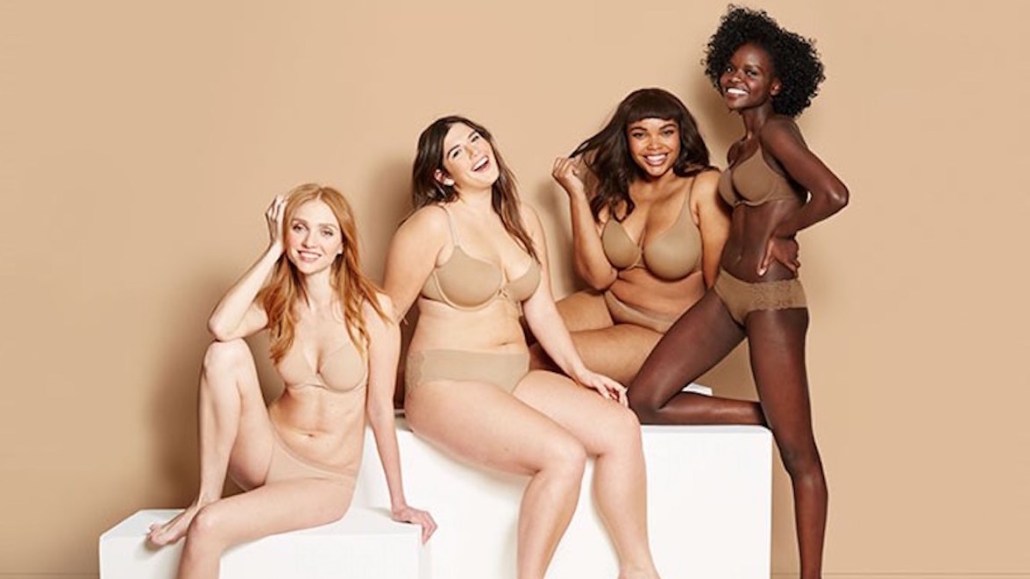Save 50% on a 3-month Digiday+ membership. Ends Dec 5.
Why has it taken mass retailers like Target so long to diversify their product?


Target is finally following in the footsteps of smaller brands like Nubian Skin and Naja by diversifying its fashion product offerings. It has started with lingerie and hosiery under its in-house Merona line, both of which come in a wide range of skin-colored tones, including cocoa, caramel, honey beige and mochaccino. Target intends to do the same with its intimates and shoe lines this coming fall.
“At Target, we know that women come in all shapes, sizes and ethnicities, and our assortment needs to reflect their outfitting needs,” Target’s senior vice president of apparel and accessories, Michelle Wlazlo, said in a statement, citing a push to be more inclusive.
Presumably, the fact that the world is diverse isn’t news to Target, so it’s curious why it has taken the mass retailer so long to adapt its product accordingly.
Paula Rosenblum, an analyst at Retail Systems Research, said it’s long overdue. “I think it has more to do with the body and skin type of the merchandise buyers and product designers,” she said. “There is no doubt that money has been left on the table for a very long time, so there’s just no other logic behind it.”
 A bra from Target’s updated Merona lingerie line
A bra from Target’s updated Merona lingerie line
She also believes the struggling retail market has made it harder for retailers to avoid catering to an increasingly diverse consumer base. As the latest census data shows, 17.6 percent of the U.S. population is hispanic, and 13.3 percent is black. What’s more, according to Pew Research, the U.S. will not have a single ethnic majority by 2055.
Rosenblum recalled a brief conversation she had with Tim Gunn some years ago, during which the fashion consultant suggested that designers were “too lazy to expand beyond the known,” loath to put in the work required to alter their color palettes and patterns.
“Now that retailers are having tough times, however, they seem a bit more willing to think outside the box,” she said. “I hope that’s the good that comes out of this difficult period in retailing: the recognition that not all women are white, five-foot-six and a size 2.”
Greg Girard, a program director at IDC Retail Insights, also emphasized the challenges inherent to introducing new product at these larger companies. These spanned “understanding the market, developing the style (in this case, color) strategy, understanding the market trends within which tone preferences of various populations will evolve, and executing the color strategies through the product lifecycle management process, [which involves] specification, sample generation, review and approval.”
They also have to consider the allocation of product across various regions and stores. “Adding color variations increases the number of SKUs within styles and sizes: [if] you add four new tones to a style sold in four sizes, you’ve added 16 SKUs,” he said, noting that added SKUs means inventory risk across Target’s chain of 1800 stores and requires its warehouses to make room for the wider range of product, often by carrying fewer unique styles.
 Hosiery from Target’s updated Merona line
Hosiery from Target’s updated Merona line
What’s more, he said, different populations have different “size curves,” so demand for each size will vary by color. “This is already seen in the size curves of, say, women’s tops,” he said, citing the example that fewer large tops are sold in lighter colors, as a result of the notion that “black is slimming.”
“All of this leaves a large retailer facing two more issues: [a greater] end-of-season markdown risk (too many to the wrong stores) and in-season out-of-stock risk (too few to the right stores),” said Girard.
As some see it, the “right” stores for diverse product offerings — if available — are big metro areas like Los Angeles and New York. “They’re less likely to allocate shelf space to products that aren’t aligned with their immediate core demographics,” said Christina Hungspruke, a senior director of corporate marketing at ORC International.
Consumers living in other parts of the country turn to smaller specialty brands. “They’re happy to shop direct and even pay the higher price for that expertise and customization, [so these brands] capture a large share of market from big box retailers,” said Hungspruke. “If big box retail won’t stock, women of color won’t shop.”
One of those specialty brands is Nubian Skin, a lingerie and shoe line launched in 2014 for women of color. Interestingly, the brand spent time a few years ago working with Target on a diffusion line that Target ultimately decided against. (It was unclear as to why, said a rep from Nubian Skin.) News of Target’s new launch has the company feeling somewhat ambivalent: “As a smaller [company] who was first-to-market with the concept, you do worry about protecting your brand, but we have a loyal customer base and, ultimately, it is great for the consumer,” said the Nubian Skin rep.
 An image from a recent Nubian Skin lookbook
An image from a recent Nubian Skin lookbook
And it wouldn’t be surprising to see more mass retailers follow in Target’s footsteps soon.
As Girard sees it, there are ways around all of the challenges to such product expansion. “Larger retailers can use an omni-channel or endless aisle strategy to overcome the [warehouse] inventory risk,” he said, by way of example. “This entails carrying a smaller range of colors in each store, localized for each store’s demographics, and making ‘long tail’ colors available through e-commerce orders placed from the store when the customer is there.”
That solution isn’t the easiest, he noted, but it can be done.
More in Marketing

Behind the rise of the chief productivity officer and what it means for companies and employees
The CPO is envisioned as the leader who orchestrates people and technology together to drive business outcomes.

OpenX redraws the SSP-agency relationship
The gradual realignment of programmatic’s middlemen discussed at Digiday’s Programmatic Marketing Summit.

Omnicom’s reshuffled leadership emerges as the ad industry’s new power players
Omnicom’s Black Monday saw thousands of jobs cut, and a chosen few put in charge of what is now the world’s largest marketing services group. They face a number of challenges, however.








